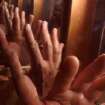
We had an interesting and thought-provoking discussion today about student reading comprehension, literacy, images and learning styles. Here is just a sampling of the ideas shared and questions raised: (feel free to add a comment – see link below this post)
How do images play into the “literacy realm” or the “traditional literacy realm”? Are they an integrated part or treated as a separate medium?
Students are officially taught reading literacy, but we are never taught how images affect us and analyzing what is important (i.e.- media literacy – see The Center for Media Literacy
Are students more visual now than in years past? When do they adapt to ignoring images in text and why? Do we (educators) do this? Publishers?
Pictures can be considered a multilingual medium… is this the cause or effect of why we are becoming a more visual society (because our society and culture is extending beyond English & “Americanism” toward a true melting pot of cultures).
Do you have anything in your syllabus about the importance of images, graphs, charts, diagrams and their application to the textual knowledge?
Images portray emotions, often invoking a reaction or response. How does this play into the learning experience? (a picture says a 1000 words) What can be stated better with an image instead of words?
How much “peripheral learning” is being missed now since students can simply search for specific phrases or keywords in a web page or digital document rather than accidentally learning something along the way to finding the “hidden” required information within a body of text. (Similar to a long road trip to a destination vs. an airplane ride… how much peripheral learning did we acquire while in the midst of constantly repeating, “Are we there yet?!”)
What about doing something by hand versus using a computer program that does it automatically? (Ex.- only create graphs on computers or make some/one by hand too). Similar to typing 2 + 2 into a calculator and getting 5… “so that must be the right answer because that’s what the calculator says”.
In order to bring images to the forefront of students’ consciousness, consider digital or visual storytelling – similar to picture books – have students create or gather images to incorporate into a lesson or presentation. Sometimes just an image (with no text) can be more powerful than any words can convey, whether a paper copy or digital.
Have students keep a journal of their learning experiences and application attempts. Better yet, keep a journal yourself – listing your observations, insights and reflections about what’s going on in the classroom and in your student’s minds, where you want to go next or try next time teaching this lesson.
An interesting point came up about skimming to find information… How many readers of research go directly from abstract to conclusion vs. reading methodologies and results first? Why is that? (Time is an obvious factor here) Along those same lines, is the image vs. text issue with students simply a factor of time and efficiency? At what cost?
“Merely descriptive” research is often looked down upon thanks to the emergence of quantitative analysis a couple decades ago. With numbers to back up conclusions, the value of descriptive analyses has been overlooked, in both the sciences and non-sciences. Is this possibly partly due to our migration away from the narrative voice?
To sum it up, there were many reflections today that come down to the realization that there are multiple ways of knowing – for both student and teacher – and for most of what we teach, there is not only one answer or path to learning, but rather many possible routes toward that ideal common destination… wherever that may be. For your students’ sake, be sure to keep those roads open, easily located, and allow for detours as necessary!
No comments:
Post a Comment